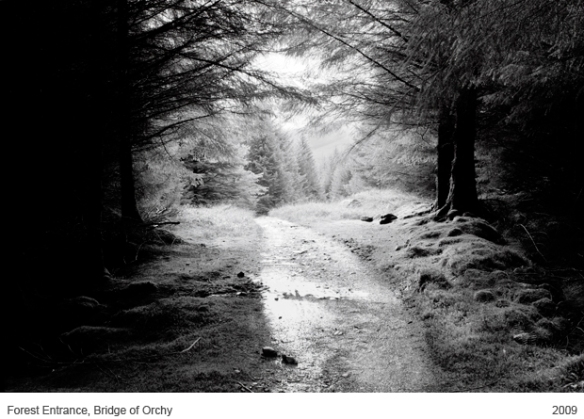


At first glance, the work of Scottish photographer Philip Braham seems to be a simple series of postcard-pretty (albeit slightly haunting) black & white photographs of Scottish landscapes. But, much like Scotland itself, beyond the surface lays something darker.
Sadly, beautiful Scotland has one of the highest suicide rates in Europe, almost twice the rate of the rest of the UK. Inspired by the high-profile case of Irene Hogg, a Scottish headmistress who ended her life after a critical school inspection, Braham began following cases of suicide reported in the media and documenting the sites as sacred spaces. Calling his project Suicide Notes, each landscape is a haunting photographic monument to a real person who committed suicide there. In the words of the artist:
The conscious decision to take one’s life in the open, before nature, I believe represents a private farewell to the world and a stark acknowledgement that one is utterly alone in death if not in life. The landscapes here represent the last scenes in the final act of lives too broken to continue. They stand as modest monuments to the subjects absent in this series of photographs.
The artist does not reveal any personal details about the deceased, but the landscapes nonetheless seem to become deeply personal portraits of the people who ended their lives in them. Armed with knowledge of the tragic events that took place there, each image becomes saturated with a dark but beautiful pathos. Braham’s quiet and slightly eerie style of photography captures the ghosts of the place: a fitting tribute to individual grief and a poetic response to a pressing social problem in Scotland.





// All images via the artist’s website. Special thanks to the wonderful Rhona Rhamsay, Learning & Access Curator at the University of St Andrews, who gave me the idea for this post.
Elsewhere on the Museum of Ridiculously Interesting Things:


Pingback: Stripping it off and ripping it off: Christian Thompson’s Emotional Striptease | The Museum of Ridiculously Interesting Things
Pingback: Tibi Tibi Neuspiel’s strange sandwiches | The Museum of Ridiculously Interesting Things
Pingback: Last meals of death row convicts by James Reynolds | The Museum of Ridiculously Interesting Things
Pingback: The mysterious coffins of Arthur’s Seat | The Museum of Ridiculously Interesting Things
Pingback: The unsettling aesthetic of Petrina Hicks | The Museum of Ridiculously Interesting Things
Pingback: Abandoned suitcases of insane asylum patients | The Museum of Ridiculously Interesting Things
Pingback: EJ Bellocq and the Storyville prostitutes | The Museum of Ridiculously Interesting Things
Memorials are for the living, not the dead. You cannot add dignity to a life that is ended. You can only decide to remember that life with dignity. These photos are haunting… and should be. How many places near your home would also be thought suitable to end a life? How many times per day do we treat each other less well than we could or should? Will you pick a place as hauntingly beautiful as these? Will you be able to pick a spot that will foment dignified regards for your final act in life?
If these pictures have a message it is to find and stop what drove so many to end their lives. Why is nobody asking why?
I agree that memorials are for the living, as are memories. I think that you can both remove dignity from a past life, as well as add dignity to it, in the way that it is remembered and memorialised. But, if a life is remembered as dignified, then historically it was, even if it is forgotten it was not lived with dignity.
I think you have to (a) be a very good photographer to do a project like this properly, with the respect it deserves and (b) extremely confident in your abilities to even begin such a project. Terrific photos that add dignity to the lives that passed in these locations.
Well put. In the wrong hands a project like this could be really disturbing, tacky or offensive, but I think that Braham really manages to inject both the landscape and the general subject with a humanity that speaks to his talent as a photographer. I’m glad to hear someone else sees it too, and very interested to find out if others react differently to this series.